|
|
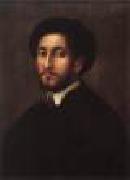 |
FOSCHI, Pier Francesco
|
|
Italian painter, Florentine school (b. 1502, Firenze, d. 1567, Firenze)
was an Italian painter active in Florence in a Mannerist style. He was pupil of Andrea del Sarto and assisted Pontormo with his frescoes at Careggi in 1536. He completed 3 altarpieces, commissioned in 1540C1545 for the church of Santo Spirito in Florence: an Immaculate Conception, Resurrection , and a Transfiguration. Foschi was also influenced by and Il Bronzino. One of his pupils was Alessandro Fei. Also called Pier Francesco di Jacopo Foschi or Toschi. He was the son of Pierfrancesco di Jacopo Sandro Foschi, known for his Madonna and Child with the Infant Saint John. (Utah Museum of Fine Arts). Foschi is best noted for his portraits painted between 1530 and 1540, including his Portrait of a Lady (Museo Thyssen-Bornemisza), Portrait of a Young Man Weaving a Wreath of Flowers (Utah Museum of Fine Arts), and his Portrait of a Man, (Uffizi Gallery). In his portraits he adhered to Mannerist style, utilizing a slight Contrapposto in the sitter with their head turned from the body. This pose gave the depiction a spontaneity and sense of movement for the innovative Mannerists, but was eventually so formulaic that it lost its intention of originality. |
|
|
|
|
|
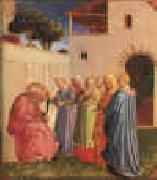 |
Fra Angelico
|
|
Fra Angelico Galleries
b.c. 1400, Vicchio, Florence
d.Feb. 18, 1455, Rome
Fra Angelico (c. 1395 ?C February 18, 1455), born Guido di Pietro, was an Early Italian Renaissance painter, referred to in Vasari's Lives of the Artists as having "a rare and perfect talent".
Known in Italy as il Beato Angelico, he was known to his contemporaries as Fra Giovanni da Fiesole (Brother John from Fiesole). In Giorgio Vasari's Lives of the Artists, written prior to 1555, he was already known as Fra Giovanni Angelico (Brother Giovanni the Angelic One).
Within his lifetime or shortly thereafter he was also called Il Beato (the Blessed), in reference to his skills in painting religious subjects. In 1982 Pope John Paul II conferred beatification, thereby making this title official. Fiesole is sometimes misinterpreted as being part of his formal name, but it was merely the name of the town where he took his vows, used by contemporaries to separate him from other Fra Giovannis. He is listed in the Roman Martyrology as Beatus Ioannes Faesulanus, cognomento Angelicus??"Blessed Giovanni of Fiesole, nicknamed Angelico".
Fra Angelico was working at a time when the style of painting was in a state of change. This process of change had begun a hundred years previous with the works of Giotto and several of his contemporaries, notably Giusto de' Menabuoi, both of whom had created their major works in Padua, although Giotto was trained in Florence by the great Gothic artist, Cimabue, and painted a fresco cycle of St Francis in the Bardi Chapel in Santa Croce. Giotto had many enthusiastic followers, who imitated his style in fresco, some of them, notably the Lorenzetti, achieving great success. |
|
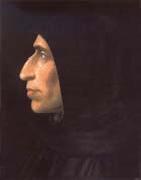 |
Fra Bartolomeo
|
|
Italian High Renaissance Painter, 1472-1517, also known as Baccio della Porta, was an Italian Renaissance painter of religious subjects. He was born in Savignano di Prato, Tuscany. He received the nickname of Baccio della Porta for his house was near the Porta ("Gate") San Pier Gattolini. Starting from 1483 or 1484, by recommendation of Benedetto da Maiano, he apprenticed in the workshop of Cosimo Rosselli. In 1490 or 1491 he began a collaboration with Mariotto Albertinelli. In the late 1490s Baccio was drawn to the teachings of Fra Girolamo Savonarola, who denounced what he viewed as vain and corrupt contemporary art. Savonarola argued for art serving as a direct visual illustration of the Bible to educate those unable to read the book. From 1498 is his famous portrait of Savonarola, now in the Museo Nazionale di San Marco in Florence. The following year he was commissioned a fresco of the Universal Judgement for the Ospedale di Santa Maria Nuova, completed by Albertinelli and Giuliano Bugiardini when Baccio became a Dominican friar on July 26, 1500. The following year he entered the convent of San Marco. He renounced painting for several years, not resuming until 1504 when he became the head of the monastery workshop in obedience to his superior. In that year he began a Vision of St. Bernard for Bernardo Bianco's family chapel in the Badia Fiorentina, finished in 1507. |
|
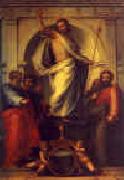 |
Fra Bartolommeo
|
|
Italian c1474-c1517
Fra Bartolommeo Location
Italian painter and draughtsman. Vasari and later historians agree that Fra Bartolommeo was an essential force in the formation and growth of the High Renaissance. He was the first painter in Florence to understand Leonardo da Vincis painterly and compositional procedures. Later he created a synthesis between Leonardos tonal painting and Venetian luminosity of colour. Equally important were his inventions for depicting divinity as a supernatural force, and his type of sacra conversazione in which the saints are made to witness and react to a biblical event occurring before their eyes, rather than standing in devout contemplation, as was conventional before. His drawings, too, are exceptional both for their abundance and for their level of inventiveness. Many artists came under his influence: Albertinelli, Raphael, Andrea del Sarto, Titian, Correggio, Beccafumi, Pontormo and Rosso Fiorentino. |
|
|
|
|
|
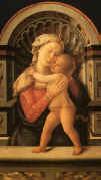 |
Fra Filippo Lippi
|
|
Italian
1406-1469
Fra Filippo Lippi Galleries
Lippi was born in Florence to Tommaso, a butcher. Both his parents died when he was still a child. Mona Lapaccia, his aunt, took charge of the boy. In 1420 he was registered in the community of the Carmelite friars of the Carmine in Florence, where remained until 1432, taking the Carmelite vows in 1421 when he was sixteen. In his Lives of the Artists, Vasari says: "Instead of studying, he spent all his time scrawling pictures on his own books and those of others," The prior decided to give him the opportunity to learn painting. Eventually Fra Filippo quit the monastery, but it appears he was not released from his vows; in a letter dated 1439 he describes himself as the poorest friar of Florence, charged with the maintenance of six marriageable nieces. In 1452 he was appointed chaplain to the convent of S. Giovannino in Florence, and in 1457 rector (Rettore Commendatario) of S. Quirico in Legania, and made occasional, considerable profits; but his poverty seems chronic, his money being spent, according to one account, in frequent amours. Vasari relates some romantic adventures of Fra Filippo that modern biographers are not inclined to believe. Except through Vasari, nothing is known of his visits to Ancona and Naples, nor of his capture by Barbary pirates and enslavement in Barbary, where his skill in portrait-sketching helped to release him. From 1431 to 1437 his career is not accounted for.
Portrait of a Man and Woman at a Casement , c. 1440
Metropolitan Museum of Art, New York City.In June 1456 Fra Filippo is recorded as living in Prato (near Florence) to paint frescoes in the choir of the cathedral. In 1458, while engaged in this work, he set about painting a picture for the convent chapel of S. Margherita of Prato, where he met Lucrezia Buti, the beautiful daughter of a Florentine, Francesco Buti; she was either a novice or a young lady placed under the nuns' guardianship. Lippi asked that she might be permitted to sit for the figure of the Madonna (or perhaps S. Margherita). Under that pretext, Lippi engaged in sexual relations with her, abducted her to his own house, and kept her there despite the nuns' efforts to reclaim her.
The result was their son Filippino Lippi, who became a painter no less famous than his father. Such is Vasari's narrative, published less than a century after the alleged events; it is not refuted by saying, more than three centuries later, that perhaps Lippo had nothing to do with any such Lucrezia, and perhaps Lippino was his adopted son, or only an ordinary relative and scholar. The argument that two reputed portraits of Lucrezia in paintings by Lippo are not alike, one as a Madonna in a very fine picture in the Pitti gallery, and the other in the same character in a Nativity in the Louvre, comes to very little; and it is reduced to nothing when the disputant adds that the Louvre painting is probably not done by Lippi at all[clarification needed]. Besides, it appears more likely that not the Madonna in the Louvre but a S. Margaret in a picture now in the Gallery of Prato is the original portrait (according to tradition) of Lucrezia Buti.
The frescoes in the choir of Prato cathedral, which depict the stories of St John the Baptist and St Stephen on the two main facing walls, are considered Fra Filippo's most important and monumental works, particularly the figure of Salome dancing, which has clear affinities with later works by Sandro Botticelli, his pupil, and Filippino Lippi, his son, as well as the scene showing the ceremonial mourning over Stephen's corpse. This latter is believed to contain a portrait of the painter, but there are various opinions as to which is the exact figure. On the end wall of the choir are S. Giovanni Gualberto and S. Alberto, while the vault has monumental representations of the four evangelists.
The close of Lippi's life was spent at Spoleto, where he had been commissioned to paint, for the apse of the cathedral, scenes from the life of the Virgin. In the semidome of the apse is Christ crowning the Madonna, with angels, sibyls and prophets. This series, which is not wholly equal to the one at Prato, was completed by Fra Diamante after Lippi's death. That Lippi died in Spoleto, on or about the 8th of October 1469, is a fact; the mode of his death is a matter of dispute. It has been said that the pope granted Lippi a dispensation for marrying Lucrezia, but before the permission arrived, Lippi had been poisoned by the indignant relatives of either Lucrezia herself or some lady who had replaced her in the inconstant painter's affections. This is now generally regarded as a fable, and indeed, a vendetta upon a man aged sixty-three for a seduction committed at the age of fifty-two seems hardly plausible. Fra Filippo lies buried in Spoleto, with a monument erected to him by Lorenzo the Magnificent; he had always been zealously patronized by the Medici family, beginning with Cosimo de Medici. Francesco di Pesello (called Pesellino) and Sandro Botticelli were among his most distinguished pupils.
The altarpiece Lippi painted in 1441 for the nuns of S. Ambrogio is now a prominent attraction in the Academy of Florence, and was celebrated in Browning's well-known poem. It represents the coronation of the Virgin among angels and saints, including many Bernardine monks. One of these, placed to the right, is a half-length portrait of Lippo, pointed out by the inscription perfecit opus upon an angel's scroll. The price paid for this work in 1447 was 1200 Florentine lire, which seems surprisingly large.
Selfportait with pupilsFor Germiniano Inghirami of Prato he painted the Death of St. Bernard. His principal altarpiece in this city is a Nativity in the refectory of S. Domenico ?? the Infant on the ground adored by the Virgin and Joseph, between Saints George and Dominic, in a rocky landscape, with the shepherds playing and six angels in the sky. In the Uffizi is a fine Virgin adoring the infant Christ, who is held by two angels; in the National Gallery, London, a Vision of St Bernard. The picture of the Virgin and Infant with an Angel, in this same gallery, also ascribed to Lippi, is disputable.
Filippo Lippi died in 1469 while working on the frescos Storie della Vergine (Scenes of the life of the Virgin Mary, 1467 - 1469) in the apse of the Spoleto Cathedral. The Frescos show the Annunciation, the Funeral, the Adoration of the Child and the Coronation of the Virgin. A group of bystanders at the Funeral includes a self-portrait of Lippi together with his son Fillipino and his helpers Fra Diamante and Pier Matteo d'Amelia. Lippi was buried on the right side of the transept.
The frescos were completed by Filippino Lippi, who also designed the funerary monument for his father. Although it was commissioned by Lorenzo de Medici it was not actually made until 1490 by an unknown Florentine sculptor. |
|
|
|
|
|
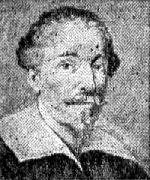 |
Francesco Albani
|
|
(March 17 or August 17, 1578 COctober 4, 1660) was an Italian Baroque painter.
Born at Bologna, his father was a silk merchant who intended to instruct his son in the same trade; but by age twelve, Albani became an apprentice under the competent mannerist painter Denis Calvaert, where he met Guido Reni. Soon he followed Reni to the so-called "Academy" run by the Carracci family: Annibale, Agostino, and Ludovico. This studio fostered the careers of many painters of the Bolognese school, including Domenichino, Massari, Viola, Lanfranco, Giovanni Francesco Grimaldi, Pietro Faccini, Remigio Cantagallina, and Reni.
In the year 1600, Albani moved to Rome to work in the fresco decoration of the gallery of the Palazzo Farnese, being completed by the studio of Annibale Carracci. Rome, under Clement VIII Aldobrandini (1592-1605) was exhibiting some degree of administrative stability and renewed artistic patronage. While pope Clement was born from a Florentine family residing in Urbino, his family was allied by marriage to the Emilia-Romagna and the Farnese, since Ranuccio I Farnese, Duke of Parma had married Margherita Aldobrandini. Parma, like Bologna, are part of the Region of Emilia-Romagna. Thus it was not surprise that Cardinal Odoarde Farnese, Ranuccio's brother, chose the Carraccis from Bologna for patronage, thereby establishing Bolognese predominance of Roman fresco painting for nearly two decades. |
|
|
|
|
|
|
|
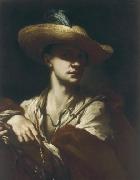 |
Francesco Caccianiga
|
|
Francesco Caccianiga (1700-1781) was an Italian painter and engraver.
He was born in Milan. In Bologna, he became a pupil of Marcantonio Franceschini. He afterwards visited Rome, where he established himself under the patronage of Prince Borghese, for whom he executed some considerable works in the Palazzo and the Villa Borghese. His principal works are at Ancona, where he painted several altar-pieces, among them, Marriage of the Virgin and Last Supper. |
|
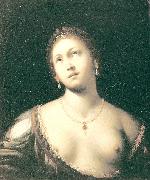 |
Francesco Cairo
|
|
(1607-1665) was an Italian painter active in Baroque Lombardy and Piedmont.
He was born and died in Milan. It is not known where he obtained his early training though he is strongly influenced by the circle of il Morazzone, in works such as the Saint Teresa altarpiece in the Certosa di Pavia.
In 1633, Cairo moved to Turin to work as a court painter, including portraits, to Vittorio Amedeo I of the House of Savoy. Between 1637-1638, Cairo travelled to Rome, where he encounters the works of Pietro da Cortona, Guido Reni and of the Caravaggisti. He returns to Lombardy to complete altarpieces for the Certosa of Pavia and a church at Casalpusterlengo. He painted a St. Theresa for San Carlo in Venice. Between 1646-1649, he returns to Turin, and paints an altarpiece for Savigliano and the church of San Salvario. He is also known as Il Cavaliere del Cairo, because in Turin, he received the order of SS. Lazarus and Maurice in recognition of his merit.
Many of his works are eccentric depictions of religious ecstasies; the saints appear liquefied and contorted by piety. He often caps them with exuberant, oriental turbans. |
|
|
|
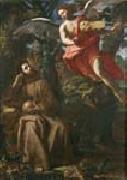 |
Francesco Cozza
|
|
1605-1682)was an Italian painter of the Baroque period.
He was born in Stilo in Calabria and died in Rome. As a young man, he went to Rome and apprenticed with Domenichino. He traveled with Domenichino to Naples.
He is best known for his expansive panegyric ceiling fresco, Apotheosis of Pamphili House, in the library of Palazzo Pamphili in Piazza Navona (1667-73). He also frescoed the Stanza del Fuoco in Palazzo Pamphili in Valmontone, 1658-59), where he worked along with Pier Francesco Mola, Gaspar Dughet, Mattia Preti, Giovanni Battista Tassi (il Cortonese), and Guglielmo Cortese. He also participated with Carlo Maratta and Domenico Maria Canuti in fresco decorations of the Palazzo Altieri. His landscape paintings recall the Carracci style of paesi con figure piccole (landscapes with small figures). He painted a Madonna del Riscatto in church of Santa Francesca Romana. He was received into the Accademia di San Luca at Rome in 1650. |
|
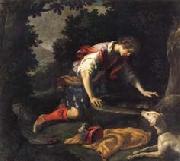 |
Francesco Curradi
|
|
Italian Baroque Era Painter, 1570-1661
son of Taddeo Curradi. He produced many devotional works and had a large clientele. At their best, the works are distinguished by lucid draughtsmanship, simple compositions and elegant, melancholy figures. Curradi was trained in the studio of Giovan Battista Naldini and in 1590 matriculated from the Accademia del Disegno, Florence. His first independent works include a Virgin and Child with Saints (1597; Volterra, S Lino) and a Birth of the Virgin (1598; Volterra Cathedral), both signed and dated. These paintings reflect the new clarity and directness introduced into Florentine painting by such artists as Santi di Tito and Jacopo Ligozzi. Subsequent works include a Crucifixion (1600) and a Virgin and Saints (1602; both Legnaia, S Angelo). In these the influence of Naldini yielded to that of Lodovico Cigoli and his circle, while the mildness of expression in the figures was inspired by Domenico Passignano. An album of 87 red chalk drawings, with scenes from the Life of St Mary Magdalene dei Pazzi (1606; Florence, convent of the Carmelites at Careggi) distinguished by their precision and clear, characteristically Florentine compositions, contributed to the iconography of this popular Counter-Reformation saint. In 1607 Curradi was commissioned to portray her mortal remains, and this painting, together with the drawings, |
|
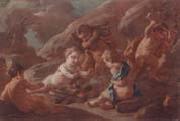 |
Francesco de mura
|
|
Italian Painter , b. 1696, Napoli, d. 1782, Napoli
was an Italian painter of the late-Baroque period, active mainly in Naples and Turin. His late work reflects the style of neoclassicism. He was a pupil of Francesco Solimena, then later with Domenico Viola, where he met his contemporary, Mattia Preti. While still in his teens he painted frescoes (1715) in San Nicola alla Carit?? in Naples. He painted ten canvases of the Virtues and an Adoration of the Magi (1728) for the church of Santa Maria Donnaromita. His other works include frescoes of the Adoration of the Magi (1732) in the apsidal dome of the church of the Nunziatella. |
|
|
|
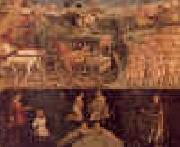 |
Francesco del Cossa
|
|
Italian
c1435-c1478
Francesco del Cossa Location
Italian painter. He was a leading representative of the Ferrarese school and was regarded, with Ercole de Roberti, as the founder of the Bolognese school. His principal works include The Glorification of March, April, and May, frescoes in the Schifanoia Palace, Ferrara; some admirable portraits of the artist contemporaries; Madonna Enthroned (Bologna); Madonna and Child with Angels, St. Liberal, and St. Lucy (National Gall. of Art, Washington, D.C.); and an altarpiece representing scenes from the life of St. Vincent Ferrer (National Gall., London, and the Vatican). |
|
 |
Francesco di Giorgio Martini
|
|
Italian Early Renaissance Painter and Sculptor, 1439-ca.1501
was an Italian painter of the Sienese School, a sculptor, an architect and theorist, and a military engineer who built almost seventy fortifications for the Duke of Urbino. Born in Siena, he apprenticed as a painter with Vecchietta. In panels painted for cassoni he departed from the traditional representations of joyful wedding processions in frieze-like formulas to express visions of ideal, symmetrical, vast and all but empty urban spaces rendered in perspective. Francesco di Giorgio is also known for architectural designs and sculptural work for Federico III da Montefeltro, Duke of Urbino, for whom he built star-shaped fortifications. He composed an architectural treatise Trattato di architettura, ingegneria e arte militare that he worked on for decades and finished sometime after 1482; |
|
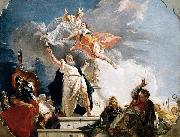 |
Francesco Fontebasso
|
|
(4 October 1707 - 31 May 1769) was an Italian painter painter of the late-Baroque or Rococo period of Venice. He first apprenticed with Sebastiano Ricci, but was strongly influenced by his contemporary, Giovanni Battista Tiepolo. In 1761, Fontebasso visited Saint Petersburg and produced ceiling paintings and decorations for the Winter Palace. Fontebasso returned to Venice in 1768. He helped decorate a chapel in San Francesco della Vigna.
He died in Venice in 1769.
|
|
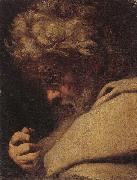 |
Francesco Fracanzano
|
|
Italian ,
b. Monopoli 1612-d.1656 Naples
Naples.Brother of Cesare Francanzano. He moved to Naples in 1622 with Cesare and like him entered Ribera's workshop. In 1632 he married Salvator Rosa's sister Giovanna. His early style remains obscure. Bologna (1958) attributed a group of paintings to him that show half-length figures against a predominantly dark background, painted in deep colours with loaded brushstrokes. These pictures, among them two versions of the Prodigal Son. |
|
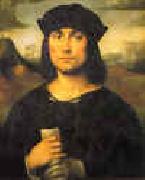 |
Francesco Francia
|
|
1450-1517
Italian
Francesco Francia Locations
He trained with Marco Zoppo and was first mentioned as a painter in 1486. His earliest known work is the Felicini Madonna, which is signed and dated 1494. He worked in partnership with Lorenzo Costa, and was influenced by Ercole de Roberti and Costa style, until 1506, when Francia became a court painter in Mantua, after which time he was influenced more by Perugino and Raphael. He himself trained Marcantonio Raimondi and several other artists; he produced niellos, in which Raimondi first learnt to engrave, soon excelling his master, according to Vasari. Raphael Santa Cecilia is supposed to have produced such a feeling of inferiority in Francia that it caused him to die of depression
His sons Jacopo Francia and Giulio Francia were also artists. |
|
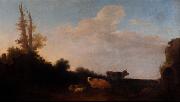 |
Francesco Giuseppe Casanova
|
|
(1727-1803) was an Italian painter and a younger brother of Giacomo Casanova.
Francesco Casanova Battaglia di cavalleria (oil on canvas, Louvre, Paris)Born in London, he trained in Venice under Francesco Guardi, then was a pupil of Francesco Simonini, a battle painter who took Borgognone as his model. Besides battle-pieces Casanova painted landscapes with figures and cattle, as well as pastoral subjects. He arrived in Paris in 1751, and went to Dresden in the following year, where he remained until 1757, spending his time in copying the finest battle-pieces of the famous Electoral Gallery. On his return to Paris he studied for a time under Charles Parrocel, and was received into the Academy in 1763. He exhibited at the Salon at intervals from that year till 1783, when he again quit France, going to Vienna, where he resided during the remainder of his life. Philip James de Loutherbourg was his pupil for a time.
|
|
 |
Francesco Granacci
|
|
1477-1543
Italian
Francesco Granacci Galleries
Born at Villamagna di Volterra, he trained in Florence at the studio of Domenico Ghirlandaio, and was employed painting frescoes for San Marco on commission of Lorenzo de'Medici. He is featured in Giorgio Vasari's Vite.
His early works were influenced from the style of Filippino Lippi, like the Enthroned Madonna between Saint Michael and John the Baptist (Staatliche Museen, Berlin), Adoration of the Child (Honolulu Academy of Arts) and four histories of Saint John the Baptist.
In 1508, Granacci went to Rome, where, with other artists, he helped Michelangelo transfer cartoons to the Sistine chapel ceiling. The two artists were lifelong friends. Returning to Florence, Granacci painted a Madonna with Child with Saints Francesco and Jerome for the Augustinian convent of San Gallo (now in the Gallery of the Academy), a Madonna della Cintola for the Company of San Benedetto Bigi, and in 1515 he participated in creating the decorations to celebrate the visit to Florence of Pope Leo X. |
|
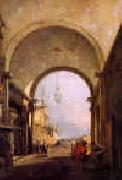 |
Francesco Guardi
|
|
1712-1793
Italian
Francesco Guardi Galleries
Francesco Guardi was born in Venice into a family of lesser nobility from Trentino. His father Domenico (born in 1678) and his brothers Niccolo and Gian Antonio were also painters, the latter inheriting the family workshop after the father's death in 1716. They probably all contributed as a team to some of the larger commissions later attributed to Francesco. His sister Maria Cecilia married the pre-eminent Veneto-European painter of his epoch, Giovanni Battista Tiepolo.
In 1735, Guardi moved to the workshop of Michele Marieschi, where he remained until 1743. His first certain works is from 1738, for a parish at Vigo d'Anuania, in Trentino. In this period he worked alongside his better-known brother, Gian Antonio. The first work signed by Francesco is a Saint Adoring the Eucarist (circa 1739).
His works in this period included landscapes as well as figure representations. His early vedutas show influence both from Canaletto and Luca Carlevarijs. On February 15, 1757 he married Maria Mattea Pagani, the daughter of painter Matteo Pagani. In the same year his brother Gian Antonio died and his first son, Vincenzo, was born. His second son, Giacomo, was born in 1764.
In 1763 he worked in Murano, in the church of San Pietro Martire, finishing a Miracle of a Dominican Saint clearly influenced by Alessandro Magnasco in its quasi-expressionistic style.
Francesco Guardi's most important later works include the Doge's Feasts, a series of twelve canvases celebrating the ceremonies held in 1763 for the election of Doge Alvise IV Mocenigo. In his later years, Canaletto's influence on his art diminished, as showed by the Piazzetta in the Ca' d'Oro of Venice. In circa 1778, he painted the severe Holy Trinity Appearing to Sts. Peter and Paul in the parish church of Roncegno.
Miracle of a Dominicane Saint (1763), Lugano, private collection.In 1782 Guardi was commissioned by the Venetian government six canvases to celebrate the visit of the Russian Archdukes in the city, of which only two remain, and two others for that of Pope Pius VI. On September 12 of that year he was admitted to the Fine Art Academy of Venice.
A stronger attention to colours is present in late works such as the Concerto of 80 Orphans of 1782, now in Munich, in the Façade of Palace with Staircase in the Accademia Carrara of Bergamo.
Guardi died at Venice in 1793. |
|
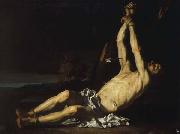 |
Francesco Guarino
|
|
(1611-1651 or 1654) was an Italian painter of the Baroque period, active mainly in the mountainous area east of Naples called Irpinia, and in other areas of Campania, Puglia, and Molise.
Francesco Guarino, Saint Agnes, 1650.He was born in Sant'Andrea Apostolo, today a frazione of Solofra in the Province of Avellino, Campania, and died in Gravina di Puglia. He was a pupil first locally of his father, Giovanni Tommaso Guarino, then moved to Naples to work in the studio of Massimo Stanzione. In Naples, like many of his contemporaries in Naples, he was influenced by the style of Caravaggio. Among his masterpieces are the works for the Collegiata di San Michele Arcangelo to Solofra.
|
|
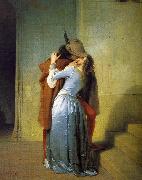 |
Francesco Hayez
|
|
1791-1882
Italian
Francesco Hayez Galleries
Hayez came from a relatively poor family from Venice. His father was of French origin while his mother, Chiara Torcella, was from Murano. The child Francesco, youngest of five sons, was brought up by his mother sister, who had married Giovanni Binasco, a well-off shipowner and collector of art. From childhood he showed a predisposition for drawing, so his uncle apprenticed him to an art restorer. Later he became a student of the painter Francisco Magiotto with whom he continued his studies for three years. He was admitted to the painting course of the New Academy of Fine Arts in 1806, where he studied under Teodoro Matteini. In 1809 he won a competition from the Academy of Venice for one year of study at the Accademia di San Luca in Rome. He remained in Rome until 1814, then moved to Naples where he was commissioned by Joachim Murat to paint a major work depicting Ulysses at the court of Alcinous. In the mid 1830s he attended the Salotto Maffei salon in Milan, hosted by Clara Maffei (whose portrait Hayez painted for her husband), and he was still in Milan in 1850 when he was appointed director of the Academy of Brera there.
Assessment of the career of Hayez is complicated by the fact that he often did not sign or date his works. Often the date indicated from the evidence is that at which the work was acquired or sold, not of its creation. Moreover he often painted the same compositions several times with minimal variations, or even with no variation. His early works show the influence of Ingres and the Nazarene movement. His later work participates in the Classical revival. |
|
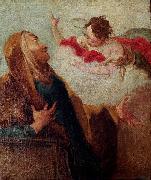 |
Francesco Maria Raineri
|
|
(February 2, 1676 - February 28, 1758) was an Italian painter of the late-Baroque, mainly active in Mantua.
Also called Lo Schivenoglia after the town, just outside of the city of Mantua, of his birth. He was a pupil of Giovanni Canti. Among his works, he was known for his paintings of battle scenes, landscapes, and cappriccios (vedute of imaginary scenes) with historical or mythologic figures. He was named director of the Academy of painters in Mantua in 1752. He is known to have painted a St. Sebastian for the chapel of Santa Anna. |
|
 |
Francesco Maria Schiaffino
|
|
Italian Rococo Era Sculptor, 1688-1763,Brother of Bernardo Schiaffino. He was the pupil and then assistant of Bernardo, who in 1721 sent him to complete his training in Rome, where he entered the workshop of Camillo Rusconi. He remained there until 1724, enriching his technique and cultural education by studying the works of Bernini, Rusconi and other sculptors. Back in Genoa, he executed such works as St Dominic (Genoa, Teatro Carlo Felice), in which Rusconi's influence is evident. The marble group of Pluto and Proserpine, sculpted for the Durazzo family and still in its original location (Genoa, Pal. Reale), is based on a bozzetto by Rusconi. In 1731 Schiaffino executed the grandiose Crucifix with Angels for King John V of Portugal (Mafra, Convent) and in 1738 began the theatrical funeral monument to Caterina Fieschi Adorno (Genoa, SS Annunziata di Portoria). The wax models of the Eight Apostles and Four Doctors of the Church that he modelled in 1739 (all untraced) were clearly inspired by the large Apostles by Rusconi and other sculptors in S Giovanni in Laterano, Rome. They were made for the stuccoist Diego Francesco Carlone so that he could, under Schiaffino's directions, execute 12 monumental statues in stucco (Genoa, S Maria Assunta in Carignano). In these latter works the classicizing authority of Rusconi's figures was transformed into a freer and more restless arrangement, the compact forms dissolving in the light, animated draperies. The statues reveal how Schiaffino had combined his knowledge of Roman sculpture with his study of Pierre Puget's Genoese works and with the style of the Piola workshop. He emulated the free rhythms of the Rococo found in the painting of Gregorio de' Ferrari, developing a decorative approach that is even more marked in the Assumption of the Virgin (1740; Varazze, S Ambrogio) and in the Rococo chapel of S Francesco da Paola (1755; Genoa, S Francesco da Paola), which he covered in polychrome marbles. His last works include the Virgin of Loreto (1762; Sestri Levante, Parish Church).
|
|
|
|
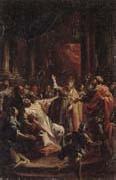 |
Francesco Monti
|
|
Italian Painter, 1685-1768
Italian painter and draughtsman. He was the son of a tailor who served the Este court in Modena during the 1690s. Monti studied with the foremost painter in Modena, Sigismondo Caula (b 1637), for three years from c. 1700. In 1703 he moved to Bologna and entered the studio of Giovanni Gioseffo dal Sole. Roli (1962) defined the formative influences on Monti's art as dal Sole and Donato Creti on the one hand, and Giuseppe Maria Crespi and Antonio Gionima on the other. Monti evolved a distinctive personal idiom, characterized by graceful figures reminiscent of the style of Parmigianino, but perhaps more directly inspired by the more extravagant late Mannerist idiom of such painters as Bartholomeus Spranger and Josef Heintz I of the court of Rudolf II at Prague. Monti may have known their work through prints by Aegidius Sadeler II, Jan Muller and others. This exotic figure style, with fluent, swaying forms and faces suggestively muted by half-shadow was accompanied by unusual shades of colour that glow richly in darkened settings. Monti's art contributed to a neo-Mannerist strain in 18th-century Emilian painting |
|
|
|
 |
Francesco Morone
|
|
Italian Painter, 1471-ca.1529
was an Italian painter, active in Verona in a Renaissance style. He was the son of the Veronese painter Domenico Morone. The art biographer Vasari praised his frescoes (1505-7) for the cupola of the sacristy in Santa Maria in Organo. He also painted the organ shutters in that church. Paolo Cavazzola was one of his pupils. |
|
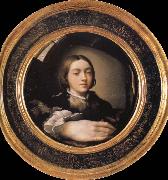 |
Francesco Parmigianino
|
|
1503 ~ 1540,Italian painter, draughtsman and printmaker. Beginning a career that was to last only two decades, he moved from precocious success in the shadow of Correggio in Parma to be hailed in the Rome of Clement VII as Raphael reborn. There he executed few large-scale works but was introduced to printmaking. After the Sack of Rome in 1527, he returned to northern Italy, where in his final decade he created some of his most markedly Mannerist works. Equally gifted as a painter of small panels and large-scale frescoes both sacred and profane, he was also one of the most penetrating portrait painters of his age. Throughout his career he was a compulsive draughtsman, not only of preparatory studies for paintings and prints, but also of scenes from everyday life and of erotica. |
|
|
|
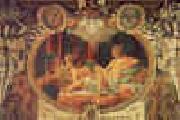 |
Francesco Primaticcio
|
|
Italian 1504-1570 Francesco Primaticcio Gallery
Born in Bologna, he trained under Giulio Romano in Mantua and became a pupil of Innocenzo da Imola, executing decorations at the Palazzo Te before securing a position in the court of Francis I of France in 1532.
Together with Rosso Fiorentino he was one of the leading artists to work at the Chateau Fontainebleau (where he is grouped with the so-called "First School of Fontainebleau") spending much of his life there. Following Rosso's death in 1540, Primaticcio took control of the artistic direction at Fontainebleau, furnishing the painters and stuccators of his team, such as Nicol?? dell'Abate, with designs. He made cartoons for tapestry-weavers and, like all 16th-century court artists, was called upon to design elaborate ephemeral decorations for masques and f??tes, which survive only in preparatory drawings and, sometimes, engravings. François trusted his eye and sent him back to Italy on buying trips in 1540 and again in 1545. In Rome, part of Primaticcio's commission was to take casts of the best Roman sculptures in the papal collections, some of which were cast in bronze to decorate the parterres at Fontainebleau.[1]
Primaticcio retained his position as court painter to François' heirs, Henri II and François II. His masterpiece, the Salle d'Hercule at Fontainebleau, occupied him and his team from the 1530s to 1559.
Primaticcio's crowded Mannerist compositions and his long-legged canon of beauty influenced French art for the rest of the century.
Primaticcio turned to architecture towards the end of his life, his greatest work being the Valois Chapel at the Abbey of Saint-Denis, although this was not completed until after his death and was destroyed in 1719. |
|
|
|
|
|
|
|
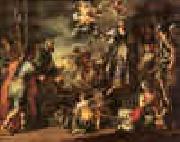 |
Francesco Solimena
|
|
1657-1747
Italian
Francesco Solimena Gallery
Francesco Solimena was born in Canale di Serino, near Avellino.
He received early training from his father, Angelo Solimena, with whom he executed a Paradise for the cathedral of Nocera (place where he spend a big part of his life) and a Vision of St. Cyril of Alexandria for the church of San Domenico at Solofra.
He settled in Naples in 1674, there he worked in the studio of Francesco di Maria and later Giacomo del Po[1]. He apparently had taken the clerical orders, but was patronized early on, and encouraged to become an artist by Cardinal Vincenzo Orsini (later Pope Benedict XIII)[2]. By the 1680s, he had independent fresco commissions, and his active studio came to dominate Neapolitan painting from the 1690s through the first four decades of the 18th century. He modeled his art??for he was a highly conventional painter??after the Roman Baroque masters, Luca Giordano and Giovanni Lanfranco, and Mattia Preti, whose technique of warm brownish shadowing Solimena emulated. Solimena painted many frescoes in Naples, altarpieces, celebrations of weddings and courtly occasions, mythological subjects, characteristically chosen for their theatrical drama, and portraits. His settings are suggested with a few details??steps, archways, balustrades, columns??concentrating attention on figures and their draperies, caught in pools and shafts of light. Art historians take pleasure in identifying the models he imitated or adapted in his compositions. His numerous preparatory drawings often mix media, combining pen-and-ink, chalk and watercolor washes.
Francesco Solimena 'A study for the fresco cycle in the Sacristy of San Paolo Maggiore in Naples', Whitfield Fine Art.A typical example of the elaborately constructed allegorical "machines" of his early mature style, fully employing his mastery of chiaroscuro, is the Allegory of Rule (1690) from the Stroganoff collection, which has come to the State Hermitage Museum, St Petersburg.
He apparently hoped to see his son Orazio follow a career in the law, for which he received a doctorate (de Domenici), but also became a painter.
His large, efficiently structured atelier became a virtual academy, at the heart of cultural life in Naples. Among his many pupils were Francesco de Mura (1696-1784) , Giuseppe Bonito (1707-89), Pietro Capelli, Gaspare Traversi, and most notably Corrado Giaquinto and Sebastiano Conca. The Scottish portraitist Allan Ramsay spent three years in Solimena's studio. Solimena amassed a fortune, was made a baron and lived in sumptuous style founded on his success.
Francesco Solimena died at Barra, near Naples, in 1747. |
|
|
|
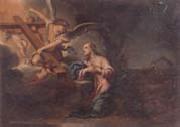 |
Francesco Trevisani
|
|
Italian Rococo Era Painter , Capodistria 1656-1746 Rome
was an Italian painter, active in the period called either early Rococo or late Baroque (barochetto) Born in Capodistria (modern Koper, then part of the Republic of Venice), he was the son of Antonio Trevisani, an architect, by whom he was instructed in the first rudiments of design. He then studied in Venice under Antonio Zanchi. He moved to Rome, where he remained until his death, in 1678. His brother, Angelo Trevisani remained a prominent painter in Venice. In Rome, he was supported by Cardinal Pietro Ottoboni. He was strongly influenced by Carlo Maratta, as it is manifest in his masterpiece, the frescoes in San Silvestro in Capite (1695-1696). In this commission, he worked alongside Giuseppe Chiari and Ludovico Gimignani. In Rome, he was favored with the patronage of Cardinal Chigi. Chigi employed him in several considerable works, and recommended him to the protection of Pope Clement XI, who not only commissioned him to paint one of the Prophets in San Giovanni Laterano, but engaged him to decorate the cupola of the cathedral in Urbino. There he represented, in fresco, allegories of the four Quarters of the World, in which he displayed much invention and ingenuity. He was employed by the Duke of Modena, in copying the works of Correggio, Parmigianino, and also painted in Brunswick, Madrid, Munich, Stockholm, and Vienna. He also shows Maratta's influence in the cartoons for baptismal chapel in St. Peter's Basilica, in the oval with Prophet Baruch in San Giovanni in Laterano, and in the Death of St. Joseph in Sant'Ignazio. Trevisani painted scenes from the Life of the Blessed Lucy of Narni in the church of Narni (1714-15). |
|
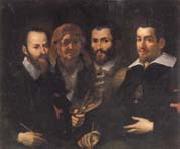 |
Francesco Vanni
|
|
Italian Baroque Era Painter, 1563-1610
was an Italian painter of the Mannerist style, active in Rome and his native city of Siena. He was half-brother of the painter Ventura Salimbeni, and the stepson of Arcangelo Salimbeni, another Sienese painter. His stepfather died when Francesco was young, and as a 16 year old went first to Bologna, then to Rome. There he apprenticed with Giovanni de' Vecchi during 1579-80, though like other Tuscan painters of his day, he was influenced in part by Federico Barocci from Urbino, and he was among the last painters who also reflected the influence of the Sienese School of painting. He was named a Cavalieri. In Rome, he worked later with Salimbeni, Bartolomeo Passerotti, and Andrea Lilio. He was commissioned by Pope Clement VIII to painted an altarpiece for the St. Peter's, later transferred to mosaic, Simon Magus rebuked by St. Peter. He painted several other pictures for Roman churches; including St. Michael defeats rebel angels for the sacristy of S. Gregorio; a Piet?? for Santa Maria in Vallicella; and the Assumption for S. Lorenzo in Miranda. Returning to Siena, where he ultimately died, he afterwards worked at Parma, Bologna, and again at Rome. At Siena, he painted a S. Raimondo walking on the Sea for the church of the Dominicans. Vanni painted a Baptism of Constantine (1586-7) for the church of San Agostino in Siena. He painted a Christ appearing to St. Catherine for the chapel of il Refugio at the Santuario Cateriniano of Siena, and a Baptism (1587) for the former church of San Giovannino e Gennaro. |
|
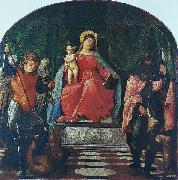 |
Francesco Vecellio
|
|
(c. 1475 - 1560) was an Italian painter of the early Renaissance, best known as the elder brother of the painter Titian. In his youth, he was a soldier. As a painter, he was mainly active in 1520-1530s in Cadore. In 1524, he signed an altarpiece for San Vito in Cadore. In 1540s, he painted a polyptych at Candide. In late 1540s he painted the organ shutters of San Salvatore in Venice. He painted an Annunciation for San Nicola di Bari, now in the Accademia.
|
|
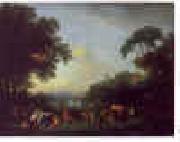 |
Francesco Zuccarelli
|
|
Italian 1702-1788
1788). Italian painter and draughtsman, active in England.
Zuccarelli training began in Florence, where he engraved the frescoes by Andrea del Sarto in SS Annunziata. He then studied in Rome under Paolo Anesi and learnt figure drawing from Giovanni Maria Morandi (1622-1717), although in this he never acquired any great skill. His earliest recorded paintings were Mary Magdalene and St Jerome (both untraced), which he contributed to the exhibition of the feast of St Luke in Florence in 1729. He also painted portraits. Around 1730 he moved to Venice and began painting landscapes exclusively. His interest in this field may have led to his becoming acquainted with the Welsh landscape painter Richard Wilson in 1750-51. Wilson painted a lively portrait of him (1751; London, Tate) in exchange for one of Zuccarellis landscapes. Zuccarelli avoided both the topographical type of Venetian view developed by Canaletto and the stormier landscapes of Marco Ricci, adopting instead a decorative landscape style of idealized Italian countryside. His subject-matter was usually unspecific rather than recognizably historical, biblical or mythological. For example, in the early 1740s he executed six paintings purporting to be scenes from the story of Jacob, but the paintings themselves bear few references to it (e.g. Landscape with Two Seated Women Embracing, 1743; Windsor Castle, Berks, Royal Col.). |
|
|

